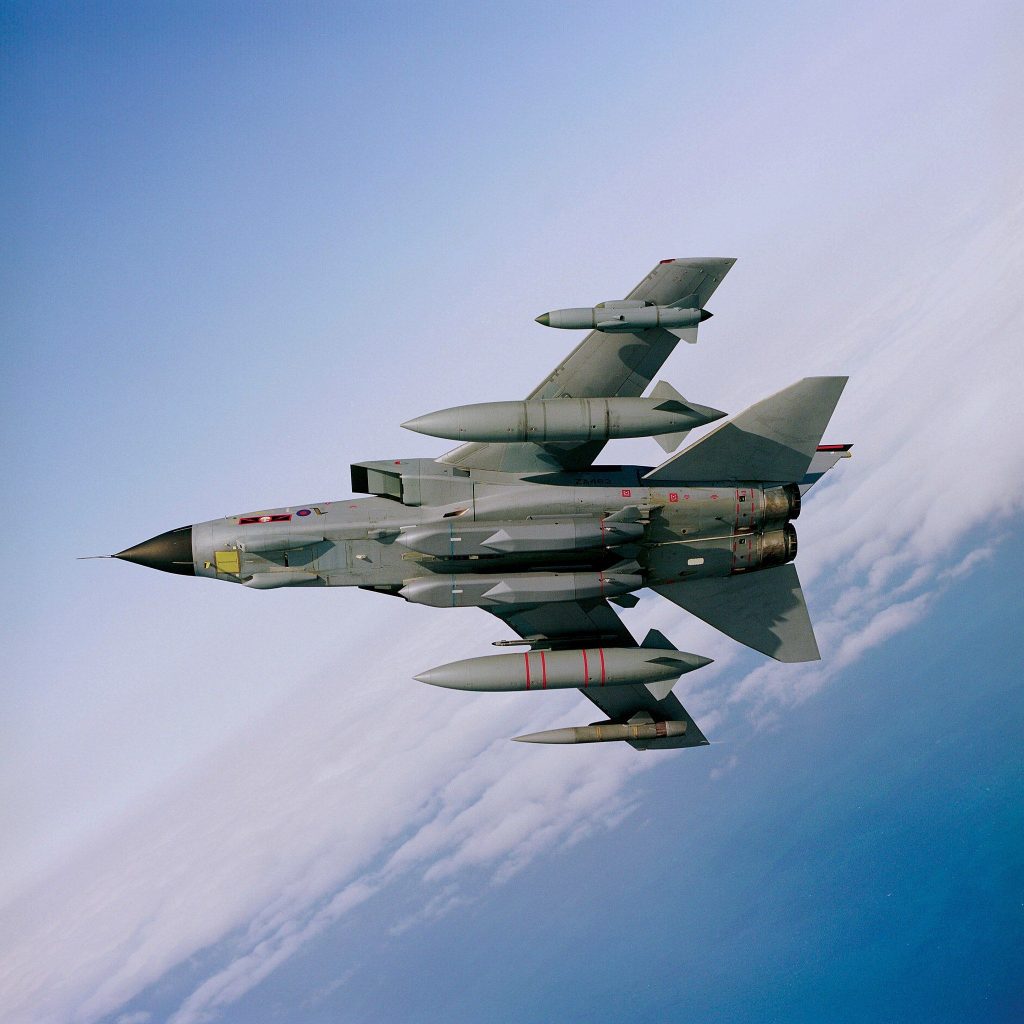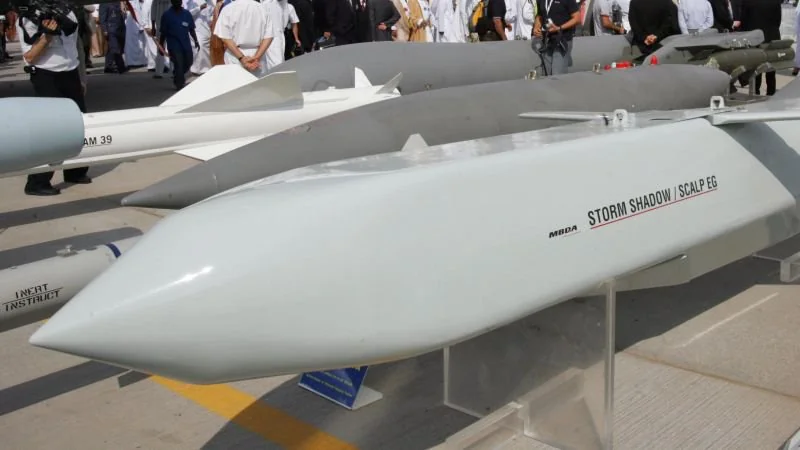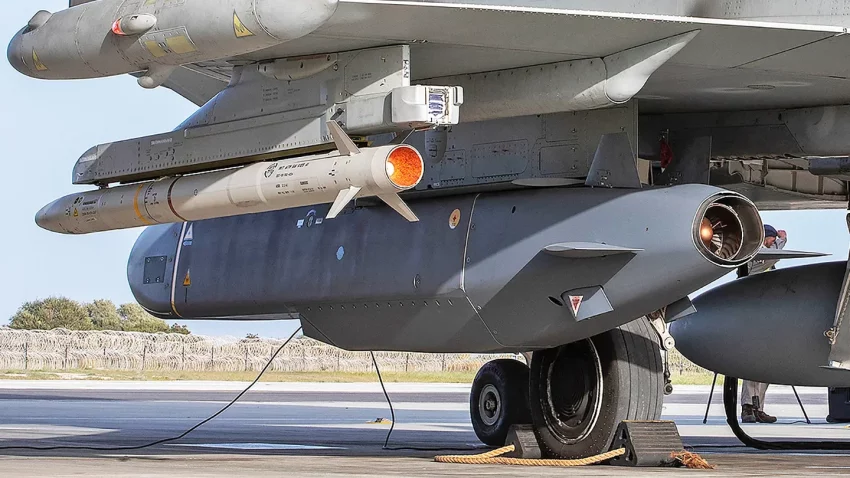The Storm Shadow and Tomahawk missiles, both long-range, subsonic cruise missiles, offer formidable capabilities in modern warfare. The Storm Shadow, developed by a European consortium led by MBDA, entered service in 2003. With a range of over 250 miles and a payload capacity of up to 1,000 pounds, it employs terrain-following guidance for low-altitude stealth flight.
In contrast, the Tomahawk, an American missile, developed by Raytheon and in service since the early 1980s, has a range of up to 1,500 miles and a payload capacity of 1,000 pounds. It utilizes various guidance systems, including terrain following, infrared, and GPS. The Storm Shadow emphasizes precision with its TERPROM system, while the Tomahawk excels in range.
What Makes the Storm Shadow Cruise Missile So Powerful?

The Storm Shadow missile, known as SCALP EG in Europe, is a sophisticated stand-off air-launched cruise missile designed to destroy hardened and buried targets.
With its considerable weight of 1,300 kg and a length of 5.1 meters, the Storm Shadow is a force to be reckoned with. Its power comes from the Turbomeca Microturbo TRI 60-30 turbine engine, which grants it an impressive range of up to 300 km, and even up to 560 km on certain occasions.
Precise Strikes from a Safe Distance
The standout feature of the Storm Shadow is its ability to deliver precision strikes from a safe stand-off distance. This allows the UK military to engage targets without entering the engagement zone of enemy anti-aircraft weapons, minimizing the risk to the launching platform.
Upon release, the missile’s wings deploy, and it activates its GPS/INS and Terrain Profile Matching TERPROM navigation systems. These systems work in tandem to guide the missile into the target area at low altitudes. Flying at low levels helps the missile avoid enemy radar detection and terrain obstructions.
Deadly Autonomy
As the missile approaches its final approach, the nose cone is jettisoned, and infrared sensors take over to guide the missile down onto its target.
During this phase, the Storm Shadow performs dramatic terminal maneuvers, ensuring precise target engagement.
One of the most impressive aspects of the Storm Shadow is its ability to operate autonomously. Once launched, it doesn’t require external guidance, making it an efficiently deadly weapon for modern warfare.
The Storm Shadow’s Role in Modern Warfare
The Storm Shadow missile’s capabilities have made it a crucial asset in modern warfare. Its precision, range, and autonomy allow military forces to confidently engage in a variety of missions. Whether used defensively to protect against imminent threats or offensively to neutralize high-value targets, the Storm Shadow plays a pivotal role in shaping the outcome of military operations.
This European missile, with its incredible capabilities, showcases the advances in technology and strategy that define the present era of warfare.
What Are the Key Features of Tomahawk Missile?
The Tomahawk cruise missile, developed by the American military, possesses several key features that set it apart as a formidable weapon system. Its impressive range, adaptability, guidance systems, and versatility make it a critical asset in modern warfare.
Exceptional Range
One of the most striking aspects of the Tomahawk is its remarkable range, extending up to 1,500 miles. This extensive reach allows it to engage targets positioned at significant distances from the launch platform. It can be launched from various platforms, including surface ships and submarines, making it a versatile tool for the U.S. Navy.
Diverse Payload Options
The Tomahawk is not only capable of delivering conventional warheads but is also designed for nuclear payloads, providing a broad spectrum of options for mission planners. Its guidance systems are multifaceted, incorporating terrain-following technology, infrared sensors, and GPS. This blend of systems ensures the missile can navigate diverse terrains and accurately strike a wide range of targets, including those with fortified defenses.
Adaptability and Stealth
The missile’s adaptability is another key strength. Different variants cater to specific mission requirements, enabling it to engage land-based and naval targets effectively. Additionally, its stealth features enhance its survivability during the flight, as it can operate at low altitudes to avoid detection by enemy radar.
Proven Effectiveness in Modern Conflicts
The Tomahawk cruise missile has demonstrated its prowess in various military conflicts and continues to be a crucial component of U.S. military strategy. Its ability to engage distant, well-defended, and high-value targets with precision ensures it remains a valuable asset for military forces seeking to achieve their objectives with confidence.
How Do Storm Shadow and Tomahawk Missiles Compare?
When comparing the Storm Shadow and Tomahawk missiles, it’s evident that both are powerful and highly capable cruise missiles. However, they have distinct features that set them apart
Range and Payload
One significant contrast between the Storm Shadow and Tomahawk missiles lies in their range and payload capabilities. The Storm Shadow has an operational range of over 250 miles, while the Tomahawk boasts an impressive range of up to 1,500 miles.
This stark difference in range can be a crucial factor when deciding which missile to employ, as it affects the ability to engage distant targets effectively.
Both missiles are designed to carry a payload of up to 1,000 pounds, but the Tomahawk’s extended range allows it to deliver this payload to targets much farther away.
This makes the Tomahawk a preferred choice for long-range precision strikes, while the Storm Shadow excels in scenarios where shorter distances are involved.
Guidance Systems
Guidance systems are a critical aspect of cruise missiles, and both the Storm Shadow and Tomahawk employ advanced technologies to ensure accuracy.
The Storm Shadow utilizes a terrain-following guidance system known as TERPROM. This system enables the missile to fly at low altitudes, closely following the contours of the terrain to evade radar detection. TERPROM ensures precise navigation and target acquisition.
Conversely, the Tomahawk missile incorporates a multifaceted guidance package that includes GPS technology, infrared sensors, and terrain-following features. These systems collectively enhance the missile’s ability to navigate diverse terrains and accurately engage targets.
While both missiles are highly accurate, the Tomahawk’s variety of guidance systems provides adaptability for different mission objectives.
Adaptability and Versatility
The Storm Shadow and Tomahawk missiles offer adaptability and versatility, but each has unique features that cater to specific mission requirements.
The Storm Shadow, with its focus on precision navigation and low-altitude flying, excels in striking fortified bunkers and high-value infrastructure. Its ability to evade radar detection makes it a valuable asset when stealth and precision are essential.
On the other hand, the Tomahawk’s versatility shines through with various variants designed to meet specific mission objectives. It can engage land-based and naval targets, offering a broad spectrum of options for military planners.
Its long-range capability positions it as a preferred choice when engaging distant targets with fortified defenses.
Historical Usage
Both the Storm Shadow and Tomahawk missiles have been used in real combat scenarios and have proven their effectiveness.
The Storm Shadow, in service since 2003, is a relatively new addition to the realm of cruise missiles. While its historical usage may not be as extensive as the Tomahawk’s, it has shown its precision and effectiveness in engagements.
In contrast, the Tomahawk has a rich history of military usage dating back to the early 1980s. It has been deployed in numerous conflicts, including the Gulf War and the Iraq War. Its extensive track record demonstrates its reliability and capability in various mission scenarios.
How Tomahawk Has Proven Effectiveness in Modern Conflicts?

The Tomahawk missile has demonstrated its effectiveness in various modern conflicts. Here’s an overview of its proven track record
Gulf War (1990-1991): During the Gulf War, the Tomahawk cruise missile played a pivotal role in the coalition’s military campaign. These missiles were used to strike key targets in Iraq, including military installations, communication facilities, and infrastructure. Their precision and long range made them valuable assets in the conflict.
Kosovo War (1999): Tomahawk missiles were deployed in the Kosovo War to target Serbian military installations and infrastructure. Their accuracy was instrumental in minimizing collateral damage and achieving strategic objectives.
War on Terror (2001): The Tomahawk missile has been used extensively in the ongoing War on Terror. U.S. Navy destroyers launched Tomahawks against Al-Qaeda and Taliban targets in Afghanistan during Operation Enduring Freedom. They were also used against ISIS targets in Syria and Iraq. The missile’s precision and ability to strike high-value targets while avoiding collateral damage made it a preferred choice in counterterrorism operations.
Libyan Civil War (2011): In the conflict in Libya, Tomahawk missiles were deployed to enforce a no-fly zone and strike against Libyan government forces. They were effective in degrading the regime’s air defenses and facilitating the mission’s success.
Syrian Civil War (2014-Present): Tomahawk missiles have been employed in response to chemical weapon attacks and other strategic targets in Syria. Their precision and long-range capabilities enable the United States to take measured actions while minimizing the risk of escalation.
Yemen Conflict (Ongoing): The U.S. Navy has used Tomahawk missiles to target Houthi rebel positions in Yemen. These strikes have been part of international efforts to support the Yemeni government and reduce the Houthi threat.
FAQ
Is BrahMos better than Tomahawk?
BrahMos and Tomahawk are both formidable cruise missiles, but comparing them involves multiple factors, including range, guidance systems, and deployment. BrahMos excels in terms of speed and firepower, while Tomahawk offers a greater range. The choice between them depends on specific mission requirements, making one potentially better than the other depending on the context.
What is the best cruise missile in the world?
Defining the “best” cruise missile is subjective and context-dependent. Several missiles, such as BrahMos, Tomahawk, and Storm Shadow, offer unique advantages, making them the best in various scenarios. The best cruise missile depends on the specific mission and the desired outcomes.
What is the fastest guided missile cruiser?
The fastest guided missile cruiser is typically a warship class, not a missile itself. Cruisers like the Ticonderoga-class and Arleigh Burke-class are known for their speed and guided missile capabilities. The speed of these cruisers can exceed 30 knots, providing excellent mobility and flexibility in naval operations.
What will replace the Storm Shadow missile?
The MBDA Spear missile is designed to replace the Storm Shadow missile in the British Armed Forces. Spear offers advanced capabilities and is adaptable for different mission requirements, ensuring its role in modern warfare.
Is Storm Shadow stealthy?
Yes, the Storm Shadow missile is considered stealthy due to its ability to fly at low altitudes while closely following terrain contours. This terrain-following technology reduces its radar signature, making it less detectable to enemy radar systems.
What is the next-generation missile?
Next-generation missiles are continually being developed, incorporating advanced technologies like hypersonic speed, improved maneuverability, and precision guidance. Examples include the Russian Kinzhal and the U.S. AGM-183A ARRW, which represent the future of missile technology.
What is the most advanced missile?
Determining the most advanced missile is complex, as it depends on various factors such as range, speed, guidance systems, and intended use. Missiles like the Kinzhal, DF-21D, and AGM-183A ARRW are considered some of the most advanced, each excelling in different aspects.
Which country has the best defense system?
Several countries have advanced defense systems, and the evaluation of which one is the best depends on specific criteria. The United States, Russia, China, and Israel are known for their sophisticated defense systems, including missile defense, cyber warfare, and air defense capabilities.
Which country has the best missile technology in the world?
The United States is often regarded as having some of the most advanced missile technology globally. It has developed a wide range of missiles for various applications, from cruise missiles to ballistic missile defense systems, consistently pushing the boundaries of missile technology.
Is Taurus better than Storm Shadow?
Comparing Taurus and Storm Shadow involves evaluating specific mission requirements. Taurus offers a longer range, while Storm Shadow excels in precision and stealth. The choice between them depends on the mission’s objectives and context.
Why are Tomahawk missiles so good?
Tomahawk missiles are highly regarded for their precision, adaptability, and range. They can be launched from various platforms and carry a diverse range of warheads, making them suitable for multiple missions. Their reliability and effectiveness in modern conflicts contribute to their reputation.
Is the Tomahawk missile the best?
The Tomahawk missile is considered one of the best cruise missiles in the world due to its adaptability, precision, and range. However, whether it’s the absolute best depends on the specific requirements and objectives of a given mission.
Final words
On the whole, the Storm Shadow missile and the Tomahawk cruise missile are both remarkable achievements in modern military technology. Each has its strengths, making them valuable assets for different mission requirements. The Storm Shadow’s precision and adaptability have made it a powerful tool in modern conflicts, while the Tomahawk’s extended range and versatility have been crucial for the U.S. military.
When comparing these missiles, it’s clear that they have distinct advantages that suit various scenarios. The choice between them depends on specific mission needs, cost considerations, and the broader strategic context in which they are deployed. As technology advances, these missiles will continue to evolve, playing pivotal roles in global security and conflicts.
The Storm Shadow missile and the Tomahawk cruise missile exemplify the constant advancements in military technology, ensuring that armed forces worldwide have the tools they need to accomplish their missions with precision and effectiveness.

